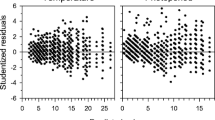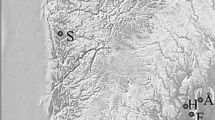Abstract
The phenology of many woody plants is controlled by an interaction of chilling requirements, photoperiod and temperature forcing. Predictions of leaf unfolding and connected ecosystem processes in global warming should thus consider not only increasing temperatures but also require a thorough understanding of the cumulative effects of daylength and temperature. In the present study, bud burst of six populations of European beech was assessed at two provenance trial sites across a latitudinal gradient of 6° within two consecutive years. Significant differences in bud burst were found among populations, trial sites and observation years. If flushing was related to the temperature forcing at trials sites, populations at the southern trial required similar temperature sums in both observation years, though the average flushing date differed by 6 days. At the northern trial site, bud burst occurred approximately 14 days later, but here the trees required 43 % degree days less to reach the same flushing state. This indicates a significant effect of the photoperiod on the temperature requirement for bud burst. The flushing sequence among populations was stable across trial sites and observation years, suggesting that similar genetic pathways regulate bud burst throughout the beech distribution. Also, it indicates that the environment of the trial location rather than the genetic origin of the populations determines its reaction to increase spring temperatures in climate change. Significant interactions of the velocity of flushing were observed between populations and trial sites, but not between populations and observation years at the same site. Together with the high variation among populations, this points to local adaptations to specific temperature-photoperiod regimes, however, adaptations to local temperature forcing seem stronger than to the light conditions.







Similar content being viewed by others
References
Aitken S, Yeaman S, Holliday J, Wang T, Curtis-McLane S (2008) Adaptation, migration or extirpation: climate change outcomes for tree populations. Evol Appl 1:95–111
Billington HL, Pelham J (1991) Genetic variation in the date of budburst in Scottish birch populations: implications for climate change. Funct Ecol 5:403–409
Chmura DJ, Rożkowski R (2002) Variability of beech provenances in spring and autumn phenology. Silvae Genet 51:2–3
Chuine I, Beaubien EG (2001) Phenology is a major determinant of tree species range. Ecol Lett 4:500–510
Chuine I, Morin X, Bugmann H (2010) Warming, photoperiods and tree phenology. Science 329:277–278
Čufar K, De Luis M, Saz MA, Črepinšek Z, Kajfež-Bogataj L (2012) Temporal shifts in leaf phenology of beech (Fagus sylvatica) depend on elevation. Trees 26:1091–1100
Davi H, Gillmann T, Cailleret M, Bontemps A, Fady B, Lefèvre F (2011) Diversity of leaf unfolding dynamics among tree species: new insights from a study along an altitudinal gradient. Agric For Meteorol 151:1504–1513
Falusi M, Calamassi R (1990) Bud dormancy in beech (Fagus sylvatica L.). Effect of chilling and photoperiod on dormancy release of beech seedlings. Tree Physiol 6:429–438
Falusi M, Calamassi R (1996) Geographic variation and bud dormancy in beech seedlings (Fagus sylvatica L.). Ann Sci For 53:967–979
Gömöry D, Paule L (2011) Trade-off between height growth and spring flushing in common beech (Fagus sylvatica L.). Ann For Sci 68:975–984
Guisan A, Thuiller W (2005) Predicting species distribution: offering more than simple habitat models. Ecol Lett 8:993–1009
Hanewinkel M, Cullmann DA, Schelhaas MJ, Nabuurs G-J, Zimmermann NE (2013) Climate change may cause severe loss in the economic value of European forest land. Nat Clim Change 3:203–207
Heide OM (1993) Dormancy release in beech buds (Fagus sylvatica L.) requires both chilling and long days. Physiol Plant 89:187–191
Howe GT, Saruul P, Davis J, Chen THH (2000) Quantitative genetics of bud phenology, frost damage, and winter survival in an F2 family of hybrid poplars. Theor Appl Genet 101:632–642
Jazbec A, Šegotić K, Ivanković M, Marjanović H, Perić S (2007) Ranking of European beech provenances in Croatia using statistical analysis and analytical hierarchy process. Forestry 80:151–162
Keeling CD, Chin JFS, Whorf TP (1996) Increased activity of northern vegetation inferred from atmospheric CO2 measurements. Nature 382:146–149
Kleinschmit J, Svolba J (1996) Ergebnisse der Buchenprovenienzversuche von Krahl-Urban. AFZ Wald 51:780–782
Körner C, Basler D (2010a) Phenology under global warming. Science 327:1461–1462
Körner C, Basler D (2010b) Warming, photoperiods, and tree phenology. Response. Science 329:279
Kramer K (1994) Selecting a model to predict the onset of growth of Fagus sylvatica L. J Appl Ecol 31:171–181
Kramer K, Leinonen I, Loustau D (2000) The importance of phenology for the evaluation of impact of climate change on growth of boreal temperate and Mediterranean forests ecosystems: an overview. Int J Biometeorol 44:67–75
Kramer K, Degen B, Buschbom J, Hickler T, Thuiller W, Sykes MT, de Winter W (2010) Modelling exploration of the future of European beech (Fagus sylvatica L.) under climate change—range, abundance, genetic diversity and adaptive response. For Ecol Manag 259:2213–2222
Kreyling J, Thiel D, Nagy L, Jentsch A, Huber G, Konnert M, Beierkuhnlein C (2012) Late frost sensitivity of juvenile Fagus sylvatica L. differs between southern Germany and Bulgaria and depends on preceding air temperature. Eur J For Res 131:717–725
Kuparinen A, Savolainen S, Schurr FM (2010) Increased mortality can promote evolutionary adaptation of forest trees to climate change. For Ecol Manag 259:1003–1008
Leech SM, Almuedo PL, O’Neill G (2011) Assisted migration: adapting forest management to a changing climate. BC J Ecosyst Manag 12:18–34
Leinonen I, Hänninen H (2002) Adaptation of the timing of bud burst of Norway spruce to temperate and boreal climates. Silva Fenn 36:695–701
Liesebach H (2012a) Genotypisierung mit nuklearen Mikrosatellitenmarkern—Möglichkeiten der Datenauswertung am Beispiel von Buchenpopulationen (Fagus sylvatica L.) aus einem Herkunftsversuch. Landbauforsch 62:221–236
Liesebach M (2012b) Der Internationale Herkunftsversuch mit Rot-Buche von 1993/95—Beschreibung der ausgewählten sechs Herkünfte und zwei Versuchsflächen. Landbauforsch 62:159–168
Liesebach M (2012c) Wachstum und phänotypische Variation von sechs Herkünften der Rot-Buche (Fagus sylvatica L.) an einem Standort in Schleswig-Holstein. Landbauforsch 62:179–192
Liesebach M, Degen B, Scholz F (1999) Zur genetischen Anpassungsfähigkeit der Rotbuche (Fagus sylvatica L.). Berichte über Landwirtschaft Münster 77:128–133
Magri D, Vendramin GG, Comps B, Dupanloup I, Geburek T, Gömöry D, Latałowa M, Litt T, Paule L, Roure JM, Tantau I, van der Knaap WO, Petit RJ, de Beaulieu J-L (2006) A new scenario for the quaternary history of European beech populations: palaeobotanical evidence and genetic consequences. New Phytol 171:199–221
Malaisse F (1964) Contribution à l’étude des hêtraies d’Europe occidendentals: Note 4: Quelques observations phénologiques de hetraies en 1963. Bull Soc Bot Belg 97:85–97
Mantau U, Merlo M, Sekot W, Welcker B (2001) Recreational and environmental markets for forest enterprises. CABI Publishing, Oxon
McLachlan JS, Hellmann JJ, Schwartz MW (2007) A framework for debate of assisted migration in an era of climate change. Conserv Biol 21:297–302
Müller J (2012) Untersuchung bodenphysikalischer, -chemischer und –hydrologischer Differenzierungen von ausgewählten Parzellen des Buchenprovenienzversuches „Schädtbek“als Voraussetzung für die Bewertung des Wachstumsverhaltens. Landbauforsch 62:169–178
Murray MB, Cannell MGR, Smith RI (1989) Date of budburst of fifteen tree species in Britain following climatic warming. J Appl Ecol 26:693–700
Nathan R, Horvitz N, He Y, Kuparinen A, Schurr FM, Katul GG (2011) Spread of North American wind-dispersed trees in future environments. Ecol Lett 14:211–219
Nielsen CN, Jørgensen FV (2003) Phenology and diameter increment in seedlings of European beech (Fagus sylvatica L.) as affected by different soil water contents: variation between and within provenances. For Ecol Manag 174:233–249
Petit RJ, Hampe A (2006) Some evolutionary consequences of being a tree. Annu Rev Ecol Evol Syst 37:187–214
Petit RJ, Hu FS, Dick CW (2008) Forests of the past: a window to future changes. Science 320:1450–1452
Putterill J, Laurie R, Macknight R (2004) It’s time to flower: the genetic control of flowering time. BioEssays 26:363–373
Robson TM, Alia R, Bozic G, Clark J, Forstreuter M, Gömöry D, Liesebach M, Mertens P, Rasztovits E, Zitová M, von Wühlisch G (2011) The timing of leaf flush in European beech (Fagus sylvatica L.) saplings. In: Genetic resources of European beech (Fagus sylvatica L.) for sustainable forestry. INIA Monographs: Serie Forestal 22, pp 61–79
Roux F, Touzet P, Cuguen J, Le Corre V (2006) How to be early flowering: an evolutionary perspective. Trends Plant Sci 11:375–381
Saikkonen K, Taulavuori K, Hyvönen T, Gundel PE, Hamilton CE, Vänninen I, Nissinen A, Helander M (2012) Climate change-driven species’ range shifts filtered by photoperiodism. Nat Clim Change 2:239–242
Savolainen O, Pyhäjärvi T, Knürr T (2007) Gene flow and local adaptation in trees. Ann Rev Ecol Evol Syst 38:595–619
Schueler S, Liesebach M, von Wühlisch G (2012) Genetische Variation und Plastizität des Blattaustriebs von Herkünften der Rot-Buche. Landbauforsch 62:211–220
Stümer W, Kenter B, Köhl M (2010) Spatial interpolation of in situ data by self-organizing map algorithms (neural networks) for the assessment of carbon stocks in European forests. For Ecol Manag 260:287–293
Sykes MT, Prentice IC, Cramer W (1996) A bioclimatic model for the potential distributions of north European tree species under present and future climates. J Biogeogr 23:203–233
Višnjić Ć, Dohrenbusch A (2004) Frost resistance and phenology of European beech provenances (Fagus sylvatica L.). Allg Forst Jgdztg 175:101–108
Vitasse Y, Basler D (2013) What role for photoperiod in the bud burst phenology of European beech. Eur J For Res 132:1–8
Vitasse Y, Delzon S, Dufrêne E, Pontailler JY, Louvet JM, Kremer A, Michalet R (2009) Leaf phenology sensitivity to temperature in European trees: do within-species populations exhibit similar responses? Agric For Meteorol 149:735–744
von Wühlisch G (2007) Series of international provenance trials of European beech. In: Improvement and silviculture of Beech, Proceedings from the 7th international beech symposium IUFRO Research Group 1.10.00, Research Institute of Forests and Rangelands (RIFR), Teheran, Iran, pp 135–144
von Wühlisch G, Krusche D, Muhs H-J (1995) Variation in temperature sum requirement for flushing of beech provenances. Silvae Genet 44:343–346
Wolf H (2011) Austrieb und Trockentoleranz von Rotbuchen-Herkünften (Fagus sylvatica L.) unter sich ändernden Klimabedingungen. Mitt Forschungsanst Waldökol Forstwirtsch 11:64–78
Acknowledgments
We gratefully acknowledge the help of Michael Mengl, Lambert Weißenbacher, and Thomas Thalmayr (BFW Vienna), as well as of Renate Rietz, Heidi Heuer and Manfred Radies (TI, Großhansdorf) during bud monitoring. Also, we would like to thank Karl Gartner (BFW) for technical support of the meteorological measurements at Gablitz and Georg von Wühlisch for the support of the monitoring at Schaedtbek. We are grateful to Wolf-Ulrich Kriebitzsch and Thomas Geburek for initiating the joint monitoring and analysis in Germany and Austria. For critical and thoughtful comments, we thank two anonymous reviewers.
Author information
Authors and Affiliations
Corresponding author
Additional information
Communicated by K.-F. Cao.
Rights and permissions
About this article
Cite this article
Schueler, S., Liesebach, M. Latitudinal population transfer reduces temperature sum requirements for bud burst of European beech. Plant Ecol 216, 111–122 (2015). https://doi.org/10.1007/s11258-014-0420-1
Received:
Accepted:
Published:
Issue Date:
DOI: https://doi.org/10.1007/s11258-014-0420-1




